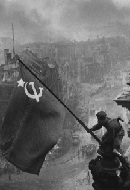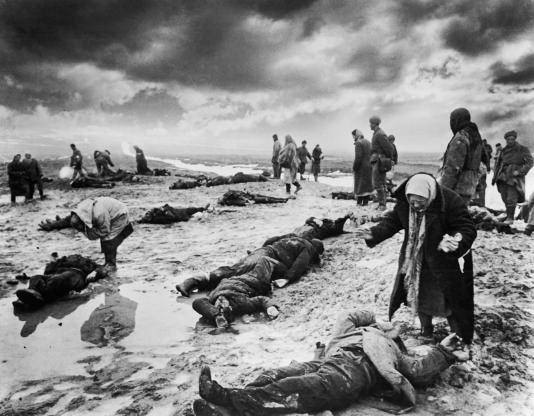Through Soviet Jewish Eyes

It is never not depressing: Any tale from the Soviet Union has to be depressing, whether it is conceived of as grotesque folly or simple tragedy, and if Jews are involved, all the more so. Jews are implicated in the creation of the Soviet Union, as its ardent supporters, and, inevitably, as victims of its apparatus of repression. No exception were the Soviet Jews who practiced the art of photography, and figured in all three roles, as David Shneer tells in Through Soviet Jewish Eyes: Photography, War, and the Holocaust.
By the beginning of the 20th century, Jews were professionally involved in photography in numbers that vastly exceeded their percentage of the population in many of the countries of Middle and Eastern Europe. There were economic and cultural reasons for this, but even after factoring them in, the preponderance of Jews in photography remains an amazing phenomenon. Shneer begins his study before the Bolshevik revolution when Pyotr Otsup (1883-1963) became one of Russia's first photojournalists, appearing regularly in Ogonyok, a popular weekly magazine published by Jews. After 1917, he became one of the first documenters of the Communist revolution. So did Moisei Nappelbaum, the leading portrait photographer of St. Petersburg's elite before the revolution, and of the new Communist elite after. Soviet portrait photographers "had an obligation to imbue an image with holiness," a requirement that Nappelbaum's iconic 1918 picture of Vladimir Lenin (who grasped early on that photography was politically useful) fulfills.
Shneer tells the story of how several generations of young Jewish men, mostly from the provinces, came to the big city, Moscow, and created and dominated the practice of Soviet photojournalism, so that the understanding the citizens of the USSR had of their country was largely mediated through Jewish eyes. In America, too, Jews played a hugely disproportionate role in the development of photographic media, but here they were not answerable to the Commissariat for Enlightenment. And what the Soviet commissars wanted was subject to change on very short notice.
Under the leadership of three Jewish editors, Ogonyok was reestablished as a Soviet magazine similar in kind to LIFE, and quickly became the most popular magazine in the USSR. Arkady Samoilovitch Shaykhet (born Avrom Shmulevitch Shaykhet) was one of Ogonyok's star photojournalists. Other Jewish photojournalists had prominent roles at Pravda and similar publications. The dominant themes in the early years of the Communist regime were development and the peaceful coexistence of the many ethnic groups in the country. The style for representing this was Socialist Realism, described by Shneer as "projecting life as it should be under socialism"—in other words, not as it really was. Mark Markov-Grinberg's photo essay about a coal miner, "Twenty-four Hours in the Life of the Filippov Family," is a classic of the genre. Shneer even devotes a chapter to the Jewish photographers like Semyon Fridlyand who documented the colonization of Birobidzhan, the area set aside as a Jewish homeland. As always, everything is depicted as hunky-dory, with modern occupations and means of socializing replacing traditional Jewish ways.
It would have been impossible for the Jews prominent in photography to escape unscathed in Stalin's Great Purges of 1937-1938. Leonid Mezhericher was accused of being a supporter of Trotsky and shot. Mikhail Koltsov was accused of being a spy and likewise shot. These two had the highest positions of state and party power among the Jewish photographers. Smaller game got off easier: Alexander Grinberg was exiled for the crime of pornography. Emmanuel Evzerikhin and many others lost their jobs. But despite the purges, by the time the Soviet Union found itself at war with Nazi Germany, 50 to 60 percent of the photojournalists covering the war were Jewish, and their exploits were frequently heroic. Many died in combat.
The three most famous Soviet photographs from World War II were taken by Jews: Georgii Zelma's "Assault," taken at Stalingrad in 1942, Dmitri Baltermants' "Grief," taken at the site of the Kerch massacre in 1942, and the most famous, Evgenii Khaldei's "Raising the Red Flag over the Reichstag," taken in 1945. Nonetheless, when the party line on the war switched mid-way through from internationalism to nationalism—that is, from ideological socialism to a pragmatic defense of the Russian homeland—anti-Semitism took its toll, and prominent Jewish photographers and journalists lost their positions. Shneer is good at explaining the pressures under which these men worked, and the shifting interpretations of that work as Soviet, Russian, or Jewish.
These differing perspectives were especially important in interpreting images of the Holocaust. Soviet troops moving from east to west encountered sites of mass killings several years before those of the other Allies, and because many of these sites were on Russian territory, the papers and magazines of the USSR ran photos of German savagery before the Western media did. Shneer writes, "The aesthetics of Nazi atrocity photography was constantly evolving during the war," a remarkable sentence. Khaldei and Baltermants were among the first to take such pictures, and understood that the victims were overwhelmingly Jewish, but which pictures were published, what they showed, and how they were captioned were political considerations. The Jewish victims at Kerch, the first mass killing ground to be liberated, were described as "the peaceful Soviet population."
Shneer uses the phrase "the ever-present absence" more than once to describe the situation of Jewish photographers whose work served the regime, but whose ethnic and religious identity could not be acknowledged. Although they did not suffer the harsh fate of the Yiddish writers in the post-war period, they were abused. For instance, in 1947 Khaldei was brought before a Communist party attestation commission that reprimanded him because, they said, "all the praise that was heaped upon him as a military photojournalist finally went to his head, and he rested on his laurels. His growth as a photojournalist stopped. The other reason has to do with Khaldei's 'cultural level,' which is exceptionally low." In 1948, after twelve years of employment at TASS, the Soviet news agency, Khaldei was fired.
My friend, the photographer Jason Eskenazi, befriended Khaldei while shooting in Russia after the collapse of the Soviet Union. The old man—whose mother had been killed in a pogrom and whose father was killed in the Holocaust—lived in a small apartment on the outskirts of Moscow. Jason describes him as "generous," and notes he showed him his World War II pistol, and would say in Russian, "Every day is a celebration." Khaldei died in 1997, and Jason dedicated his book, Wonderland: A Fairy Tale of the Soviet Monolith, to his memory.

"Grief," Dmitri Baltermants, 1942.
William Meyers writes on photography for the Wall Street Journal. See his work at www.williammeyersphotography.com.
Comments are closed for this article.




